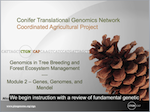Authors:
Nicholas Wheeler, Oregon State University; David Harry, Oregon State University; Heather L. Merk, The Ohio State University
Introduction
Genetic mapping is central to genomic sciences because it provides an organizational framework for the genome. The value of genetic markers is enhanced if their location in the genome is known; that is, their map position on a specific chromosome is known. In module eight we introduce the major steps in constucting a genetic map, show some examples of genetic maps in forest trees, and discuss how they are used. In coming modules it will become apparent that genetic maps play a key role in efforts to dissect complex traits into their component genetic parts, or, to state it differently, maps can help in identifying the number, location, and potential source of discrete genetic units (genes) that affect specific traits of interest.
See other Conifer Translational Genomics Network Online Modules
You can also watch the video on YouTube.
References Cited
- Barakat, A., D. S. DiLoreto, Y. Zhang, C. Smith, K. Baier, W. A. Powell, N. C. Wheeler, R. Sederoff, and J. E. Carlson. 2009. Comparison of the transcriptomes of American chestnut (Castanea dentata) and Chinese chestnut (C. mollissima) in response to the chestnut blight infection. BMC Plant Biology 9:51. (Available online at: http://dx.doi.org/10.1186/1471-2229-9-51) (verified 14 March 2011).
- Conkle, M. T. 1979. Isozyme variation and linkage in six conifer species. In: Proceedings of the Symposium on Isozymes of North American Forest Trees and Forest Insects. 27 July 1979. Berkeley, CA.
- Guries, R. P.,1S. T. Friedman, and F. T. Ledig. 1978. A megagametophyte analysis of genetic linkage in pitch pine (Pinus rigida mill.) Heredity 40: 309-314.
- Hartl, D. L., and E. W. Jones. 2006. Genetics: Analysis of genes and genomes, 6th edition. Jones and Bartlett, Sudbury, MA.
- Jermstad, K. D., D. L. Bassoni, N. C. Wheeler, and D. B. Neale. 1998. A sex-averaged genetic linkage map in coastal Douglas-fir (Pseudotsuga menziesii [Mirb] Franco var. menziesii) based on RFLP and RAPD markers. Theoretical and Applied Genetics 97: 762-770.
- Jermstad, K. D., D. L. Bassoni, K. S. Jech, N. C. Wheeler, and D. B. Neale. 2001a. Mapping of quantitative trait loci controlling adaptive traits in coastal Douglas-fir. I. Timing of vegetative bud flush. Theoretical and Applied Genetics 102: 1142-1151.
- Jermstad K. D, D. L. Bassoni, N. C. Wheeler, T. S. Anekonda, S. N. Aitken, W. T. Adams, and D. B. Neale. 2001b. Mapping of quantitative trait loci controlling adaptive traits in coastal Douglas-fir. II. Spring and fall cold-hardiness. Theoretical and Applied Genetics 102:1152-1158.
- Jermstad, K. D., D. L. Bassoni, K. S. Jech, G. A. Ritchie, N. C. Wheeler, and D. B. Neale. 2003. Mapping of quantitative trait loci controlling adaptive traits in coastal Douglas-fir. III. QTL by environment interactions and verification. Genetics 165: 1489-1506.
Tuskan G. A., S. DiFazio, S. Jansson, J. Bohlmann, I. Grigoriev, U. Hellsten, N. Putnam, et al. 2006. The genome of black cottonwood, Populus trichocarpa (Torr. & Gray). Science 313: 1596-1604. (Available online at: http://dx.doi.org/10.1126/science.1128691) (verified 14 March 2011). - Wheeler, N. C., K. D. Jermstad, K. Krutovsky, S. N. Aitken, G. T. Howe, J. Krakowski, and D. B. Neale. 2005. Mapping of quantitative trait loci controlling adaptive traits in coastal Douglas-fir. IV. Cold-hardiness QTL verification and candidate gene mapping. Molecular Breeding 15: 145-156. (Available online at: http://dx.doi.org/10.1007/s11032-004-3978-9) (verified 14 March 2011).
- White, T. L, W. T. Adams, and D. B. Neale. 2007. Forest genetics. CAB International, Wallingford, United Kingdom. Available online at: http://bookshop.cabi.org/?page=2633&pid=2043&site=191 (verified 1 June 2011).
Additional Resources
Cite This Learning Module
- Wheeler, N., and D. Harry. Genetic mapping [Online Learning Module]. Genomics in Tree Breeding and Forest Ecosystem Management, Conifer Translational Genomics Network. eXtension Foundation. Available at: https://plant-breeding-genomics.extension.org/genetic-mapping:-conifer-genomics-module-8/ (verified April 22, 2012).
Author Contributions
- Nicholas Wheeler and David Harry developed the learning module content.
- Heather Merk developed the webpage.
Funding Statement
Support for the Conifer Translational Genomics Network project and the development of the teaching modules hosted here was provided by the USDA/NRI CSREES Coordinated Agricultural Project (CAP) Award # 2007-55300-18603, the USDA/NIFA AFRI Applied Plant Genomics CAP Award #2009-85606-05680 and the USDA Forest Service. Development of this page was supported in part by the National Institute of Food and Agriculture (NIFA) Solanaceae Coordinated Agricultural Project, agreement 2009-85606-05673, administered by Michigan State University. Any opinions, findings, conclusions, or recommendations expressed in this publication are those of the author(s) and do not necessarily reflect the view of the United States Department of Agriculture.
Attachments:
Genetic_Maps.pdf (1.8 MB)
PBGworks 1106

